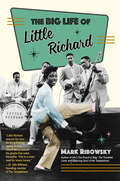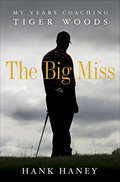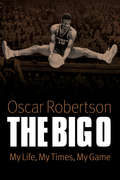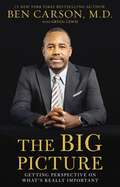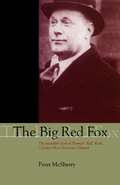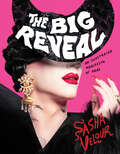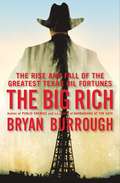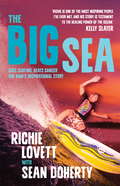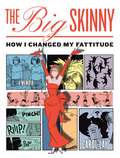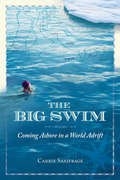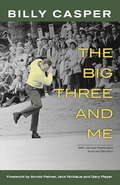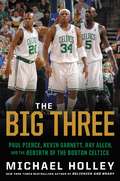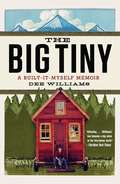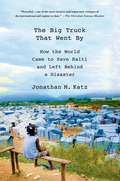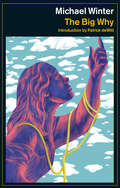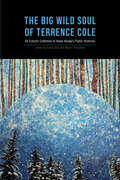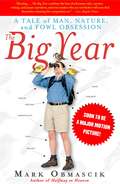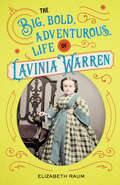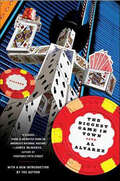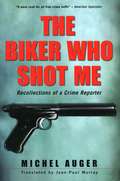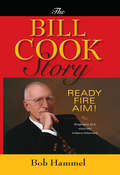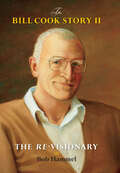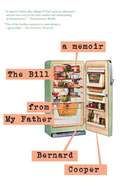- Table View
- List View
The Big Life of Little Richard
by Mark Ribowsky&“This entertaining, fast-paced biography&” of the legendary singer-songwriter &“will thrill fans of Little Richard and early rock and roll&” (Publishers Weekly). Richard Wayne Penniman, known to the world as Little Richard, blazed the trail for generations of musicians: The Beatles, James Brown, the Everly Brothers, Jimi Hendrix, the Rolling Stones, Elton John, Prince . . . the list seems endless. He was &“The Originator,&” &“The Innovator,&” and the self-anointed &“King and Queen of Rock &’n&’ Roll.&” In The Big Life of Little Richard, Mark Ribowsky shares the raucous story of his life from early childhood in Macon, Georgia, to his death in 2020. Ribowsky, acclaimed biographer of musical icons―including the Supremes, the Temptations, Stevie Wonder, and Otis Redding―takes readers through venues, gigs, and studios, conveying the sweaty energy of music sessions limited to a few tracks on an Ampex tape machine and vocals sung along with a live band. He explores Little Richard&’s musicianship; his family life; his uphill battle against racism; his interactions with famous contemporaries and the media; and his lifelong inner conflict between his religion and his sexuality. By 2020, eighty-seven-year-old Little Richard&’s electrifying smile was still intact, as were his bona fides as rock&’s royal architect: the &’50s defined his reign, and he extended elder statesmanship ever since. The Big Life of Little Richard not only explores a legendary stage persona, but also a complex life under the makeup and pomade
The Big Miss: My Years Coaching Tiger Woods
by Hank HaneyThe Big Miss is Hank Haney's candid and surprisingly insightful account of his tumultuous six-year journey with Tiger Woods, during which the supremely gifted golfer collected six major championships and rewrote golf history. Hank was one of the very few people allowed behind the curtain. He was with Tiger 110 days a year, spoke to him over 200 days a year, and stayed at his home up to 30 days a year, observing him in nearly every circumstance: at tournaments, on the practice range, over meals, with his wife, Elin, and relaxing with friends. The relationship between the two men began in March 2004 when Hank received a call from Tiger in which the golf champion asked him to be his coach. It was a call that would change both men's lives. Tiger--only 28 at the time--was by then already an icon, judged by the sporting press as not only one of the best golfers ever, but possibly the best athlete ever. Already he was among the world's highest paid celebrities. There was an air of mystery surrounding him, an aura of invincibility. Unique among athletes, Tiger seemed to be able to shrug off any level of pressure and find a way to win. But Tiger was always looking to improve, and he wanted Hank's help. What Hank soon came to appreciate was that Tiger was one of the most complicated individuals he'd ever met, let alone coached. Although Hank had worked with hundreds of elite golfers and was not easily impressed, there were days watching Tiger on the range when Hank couldn't believe what he was witnessing. On those days, it was impossible to imagine another human playing golf so perfectly. And yet Tiger is human--and Hank's expert eye was adept at spotting where Tiger's perfection ended and an opportunity for improvement existed. Always haunting Tiger was his fear of "the big miss"--the wildly inaccurate golf shot that can ruin an otherwise solid round--and it was because that type of blunder was sometimes part of Tiger's game that Hank carefully redesigned his swing mechanics. Hank's most formidable coaching challenge, though, would be solving the riddle of Tiger's personality. Wary of the emotional distractions that might diminish his game and put him further from his goals, Tiger had developed a variety of tactics to keep people from getting too close, and not even Hank--or Tiger's family and friends, for that matter--was spared "the treatment." Toward the end of Tiger and Hank's time together, the champion's laser-like focus began to blur and he became less willing to put in punishing hours practicing--a disappointment to Hank, who saw in Tiger's behavior signs that his pupil had developed a conflicted relationship with the game. Hints that Tiger hungered to reinvent himself were present in his bizarre infatuation with elite military training, and--in a development Hank didn't see coming--in the scandal that would make headlines in late 2009. It all added up to a big miss that Hank, try as he might, couldn't save Tiger from. There's never been a book about Tiger Woods that is as intimate and revealing--or one so wise about what it takes to coach a superstar athlete.
The Big O: My Life, My Times, My Game
by Oscar P. RobertsonPerhaps the greatest all-around player in basketball history, Oscar Robertson revolutionized basketball as a member of the Cincinnati Royals and won a championship with the Milwaukee Bucks. When he was twenty-three, in 1962, he accomplished one of basketball’s most impressive feats: averaging the triple-double in a single season—a feat never matched since. Cocaptain of the Olympic gold medal team of 1960; named the player of the century by the National Association of Basketball Coaches; named one of the fifty greatest players in NBA history; and inducted into the Basketball Hall of Fame in 1980—Robertson’s accolades are as numerous as they are impressive. But The Big O is also the story of a shy black child from a poor family in a segregated city; of the superstar who, at the height of his career, became the president of the National Basketball Players Association to try to improve conditions for all players. It is the story of the man forced from the game at thirty-four and blacklisted from coaching and broadcasting. But two years after he left basketball, after six years of legal wrangling, Robertson won his lawsuit against the NBA, eliminating the option clause that bound a player to a single NBA team in perpetuity and ending restrictions on free agency. The Big O is the story of how the NBA, as we now know it, was built; of race in America in the second half of the twentieth century; and of an uncompromising man and a complex hero.
The Big Picture: Getting Perspective on What's Really Important in Life
by Ben Carson Gregg LewisIn his grade school days, Ben Carson would hardly have been voted “most likely to become a famous surgeon.” His classmates had already given him another label: class dummy. Then a light clicked on for Ben—and a consuming passion for learning that catapulted him from “zero” test grades to a Yale scholarship, a pioneering role in modern medicine, and an influence that has extended from inner-city schools to corporate boardrooms and Washington corridors of power. What made the difference? Belief in his own potential, a commitment to education and making the most of his opportunities to learn, determination to make the world a better place, and faith in a God who knows no limits. Seeing the Big Picture. In The Big Picture, Ben Carson reveals the spiritual and philosophical foundations that undergird not just his dramatic career, but his approach to all of life. As in his best-selling Gifted Hands Dr. Carson shares colorful behind-the-scenes anecdotes. As in Think Big, he describes his practical principles for success. But The Big Picture is more than an autobiography or a personal-effectiveness manual. Rather, it’s a multifaceted look at the faith and vision that can see us all through hardship and failure, and stir us to bold exploits on behalf of something greater than ourselves. Dr. Carson begins by describing how he cultivated a Big-Picture perspective in his own life. Then he discusses ways to which all of us can approach parenting, family, business and friendships with the Big Picture in mind. Finally he looks at some pressing social issues—in particular, racial diversity, health care, and education—and considers how we ought to view them and what we should do about them in light of the Big Picture. Drawing on a vast array of experiences in roles ranging from trailblazing surgeon to public speaker, to husband and family man, Ben Carson shows how we can turn the course of our lives, out communities, our country, and our world by keeping the Big Picture always in mind.
The Big Red Fox: The Incredible Story of Norman "Red" Ryan, Canada's Most Notorious Criminal
by Peter McsherryShort-listed for the 2000 Arthur Ellis Award for Best Non-Fiction Norman "Red" Ryan was a notorious bank robber, safecracker, and killer. He escaped from Kingston Penitentiary twice - first by force, and then years later by gulling the credulous into believing that he was "reformed." The dupes of Ryan’s second emancipation included the prison’s Roman Catholic chaplain, several nationally prominent citizens, the country’s largest newspaper, and, ultimately, R.B. Bennett, the prime minister of Canada, who made the mistake of arranging a "political parole" for Ryan. Six people - three of them innocent victims - died as a result of Red Ryan’s freedom. Dubbed "the Jesse James of Canada" and "Canada’s most notorious criminal," Ryan had compiled a record of nineteen convictions for crimes of theft and violence, and had been in nine shooting affrays with police and citizens. He was a "lifer" in an era when "life" meant just that. Yet he got out of Kingston after just eleven and a half years and returned to Toronto, the city of his birth, amid fanfare befitting a national hero. His death in a liquor store robbery in Sarnia on May 23, 1936, just ten months after his release, was a huge jolt to Canada, and especially Toronto. How could such an obvious threat to society be paroled from prison as a paragon of reform? This question is central to The Big Red Fox. The answer lies not with Ryan himself - not even the cunning and deceitful Red Ryan could have hoodwinked his way out of a life sentence - but with those who helped him, and who benefited from his release.
The Big Reveal: An Illustrated Manifesto of Drag
by Sasha Velour“Drag embodies the queer possibility that exists within each of us—the infinite ways in which gender, good taste, and art can be lived.” –Sasha VelourThis book is a quilt, piecing together memoir, history, and theory into a living portrait of an artist and an art. Within these pages, illustrated throughout with photos and original artwork, Sasha Velour illuminates drag as a unique form of expression with a rich history and a revolutionary spirit.Each chapter strips off a new layer, removing one tantalizing glove and then another, to reveal all the twists and turns in the life of a queen. As Sasha recalls her own journey, from the women who raised her, to learning the craft of an artist, to success, disaster, and more, she also uncovers the history of queer life around the world that made it all possible.From shamans to “fairies balls,” empresses to RuPaul’s Drag Race (and beyond), The Big Reveal chronicles and celebrates our shared queer pasts. “If we want to be seen as legendary,” writes Sasha, “we have to weave ourselves into history.”From an iconoclastic drag queen comes an equally singular, thought-provoking manifesto that brings necessary and sparkling substance to our understanding of drag, queerness, beauty, and liberation!
The Big Rich: The Rise and Fall of the Greatest Texas Oil Fortunes
by Bryan BurroughIn The Big Rich, bestselling author and Vanity Fair special correspondent Bryan Burrough chronicles the rise and fall of one of the great economic and political powerhouses of the twentieth century: Texas oil. By weaving together the epic sagas of the industry's four greatest fortunes, Burrough has produced an enthralling tale of money, family, and power in the American century. Known in their day as the Big Four, Roy Cullen, H. L. Hunt, Clint Murchison, and Sid Richardson were all from modest backgrounds, and all became patriarchs of the wealthiest oil families in Texas. As a class they came to be known as the Big Rich, and together they created a new legend in America, the swaggering Texas oilman who owns private islands, sprawling ranches and perhaps a football team or two, and mingles with presidents and Hollywood stars. The truth more than lives up to the myth. Along with their peers, the Big Four shifted wealth and power in America away from the East Coast, sending three of their state's native sons to the White House and largely bank rolling the rise of modern conservatism in America. H. L. Hunt became America's richest man by grabbing Texas's largest oilfield out from under the nose of the man who found it; he was also a lifelong bigamist. Clint Murchison entertained British royalty on his Mexican hacienda and bet on racehorses and conducted dirty deals with J. Edgar Hoover. Roy Cullen, an elementary school dropout, used his millions to revive the hapless Texas GOP. And Sid Richardson, the Big Four's fun-loving bachelor, was a friend of several presidents, including, most fatefully, Lyndon Johnson. The Big Four produced offspring who frequently made more headlines, and in some cases more millions, than they did. With few exceptions, however, their fortunes came to an end in a swirl of bitter family feuds, scandals, and bankruptcies, and by the late 1980s, the era of the Big Rich was over. But as Texas native Bryan Burrough reveals in this hugely entertaining account, the profound economic, political, and cultural influence of Texas oil is still keenly felt today. Included are chapter notes, citations, bibliographic notes, and index. Bookshare Note: For the most part written factually, the author's personal bias often shows through, sometimes subtly and other times blatantly.
The Big Sea
by Richie Lovett Sean Doherty'Richie is one of the most inspiring people I've ever met, and his story is testament to the healing power of the ocean.' Kelly SlaterGoes surfing, beats cancer. One man's inspirational story.Richie Lovett might be the world?s unluckiest surfer . . . or its luckiest. We?re not quite sure which.He?s been attacked by a shark, washed into the Indonesian jungle by a tsunami, before finally being diagnosed with cancer. Unlucky? Possibly. One thing we know for sure, Richie Lovett is a survivor; he?s still here today, and what hasn?t killed him has only made him stronger.When doctors told him the cancer in his leg was buried so deep he?d never surf again, Richie ? one of the world?s best surfers ? begged to differ. After radical surgery to rebuild his leg, Rich set about the challenge of learning to surf all over again, discovering plenty about life, and himself, in the process.The Big Sea is one of sport?s most inspiring stories. But you don?t have to be a surfer or a sportsperson to know what it feels like to confront challenges. This is vital reading for anyone who?s had to face adversity or felt like they were about to be wiped out.Engagingly honest, Richie Lovett shows us that attitude is everything.
The Big Sea: An Autobiography (American Century)
by Langston HughesIntroduction by Arnold Rampersad.Langston Hughes, born in 1902, came of age early in the 1920s. In The Big Sea he recounts those memorable years in the two great playgrounds of the decade--Harlem and Paris. In Paris he was a cook and waiter in nightclubs. He knew the musicians and dancers, the drunks and dope fiends. In Harlem he was a rising young poet--at the center of the "Harlem Renaissance."Arnold Rampersad writes in his incisive new introduction to The Big Sea, an American classic: "This is American writing at its best--simpler than Hemingway; as simple and direct as that of another Missouri-born writer...Mark Twain."
The Big Skinny: How I Changed My Fattitude
by Carol LayHere’s the skinny: After a lifetime of yo-yo dieting with pills, hypnosis, and ill-informed half-measures, Carol Lay finally shed her excess pounds and kept them off. Now this California cartoonist shares her experiences in a funny, genuine, and eye-popping graphic memoir that tells Carol’s story and shows you how you can do it, too.
The Big Swim: Coming Ashore in a World Adrift
by Carrie SaxifrageHow the climate crisis changed one woman's life: &“Stunningly beautiful . . . I found myself laughing out loud on one page and brushing away tears on the next.&” —Ruth Ozeki, author of A Tale for the Time Being Climate change is alarming and complicated. Governments are acting too slowly or not at all, and not enough people feel informed or empowered enough to demand action. But ignoring a catastrophe of such magnitude is a certain path to disaster.The Big Swim puts forward the idea that personal growth arises from facing both inner tensions and threats to the biosphere. In a collection of stories that is frequently touching, surprisingly funny, and always thought-provoking, Carrie Saxifrage seeks out the places where science meets self-discovery, inviting us to join her as she: Learns the art of appreciation from an ancient jawboneHikes solo through the wilderness to find balance in a field of blueberriesSwims for four hours through cold, open water, seeking a fleeting state of grace Each of the stories in The Big Swim encourages possibilities for greater personal satisfaction with lower environmental impacts. While exploring significant topics, such as sustainable forestry, nature-centered philosophy, or First Nations&’ culture, the author discovers that the greatest adventure is learning to align how she lives with what she loves. By turning her own despair into action, she paves the way for us all to discover the many tools we have at hand to meet the biggest challenge humanity has ever faced.
The Big Three and Me
by Billy CasperBilly Casper had a higher winning percentage than Arnold Palmer, he won twice as many times on the PGA Tour as Gary Player, and during his career he finished in the top twenty-five more consistently than Jack Nicklaus. And yet, when golf historians write about the legends of the game, with special attention paid to the above-listed "Big Three," his name is often left out of the discussion, or is at best an afterthought.In this fascinating autobiography, Casper tells his life story, shining candid insight into the man who quietly collected fifty-one PGA Tour victories, the seventh highest total in history.
The Big Three: Paul Pierce, Kevin Garnett, Ray Allen, and the Rebirth of the Boston Celtics
by Michael HolleyNew York Times bestselling sportswriter Michael Holley tells the inside story of how Paul Pierce, Ray Allen, and Kevin Garnett joined together to form the most dominant team in basketball and lead the Boston Celtics to their first championship in more than two decades.The first of "The Big Three" was Paul Pierce. As Boston Celtics fans watched the team retire Pierce's jersey in a ceremony on February 11, 2018, they remembered again the incredible performances Pierce put on in the city for fifteen years, helping the Celtics escape the bottom of their conference to become champions and perennial championship contenders. But Pierce's time in the city wasn't always so smooth. In 2000, he was stabbed in a downtown nightclub eleven times in a seemingly random attack. Six years later, remaining the sole star on a struggling team, he asked to be traded and briefly became a lightning rod among fans.Then, in 2007, the Boston Celtics General Manager made two monumental trades, bringing Ray Allen and Kevin Garnett to Boston. A press conference on July 31, 2007 was a sight to behold: Pierce, KG, and Ray Allen holding up Celtics jerseys for the flood of media. Coach Doc Rivers made sure the team bonded over the thought of winning a title and living by a Bantu term called Ubuntu, which translates as "I am because we are." Rivers wanted to make it clear that togetherness and brotherhood would help them maximize their talent and win. What came next -- the synthesis of the Celtics' "Big Three" and their dominant championship run -- cemented their standing as one of great teams in NBA history, a rival to Kobe Bryant's Lakers and LeBron James's Cavaliers.This is the team that brought excitement back to the Garden, and therefore to one of the most storied franchises in all of sports. They met their historic rivals, the Lakers, in the 2008 NBA Finals, winning the series in Game 6, in a rout on their home court with a raucous, concert like atmosphere. Along the victory parade route, Paul Pierce smoked a cigar -- as a tribute to legendary former Celtics Coach Red Auerbach. In a city now defined by a wealth of championships, "The Big Three" joined the club. Michael Holley, the premier chronicler of Boston sports, brings their story to life with countless untold stories and behind-the-scenes details in another bestselling tome for New England and sports fans across the country.
The Big Tiny: A Built-It-Myself Memoir
by Dee WilliamsDee Williams’s life changed in an instant, with a near-death experience in the aisle of her local grocery store. Diagnosed with a heart condition at age forty-one, she was all too suddenly reminded that life is short, time is precious, and she wanted to be spending hers with the people and things she truly loved. That included the beautiful sprawling house in the Pacific Northwest she had painstakingly restored—but, increasingly, it did not include the mortgage payments, constant repairs, and general time-suck of home ownership. A new sense of clarity began to take hold: Just what was all this stuff for? Multiple extra rooms, a kitchen stocked with rarely used appliances, were things that couldn’t compare with the financial freedom and the ultimate luxury—time—that would come with downsizing.Deciding to build an eighty-four-square-foot house—on her own, from the ground up—was just the beginning of building a new life. Williams can now list everything she owns on one sheet of paper, her monthly housekeeping bills amount to about eight dollars, and it takes her approximately ten minutes to clean the entire house. It’s left her with more time to spend with family and friends, and given her freedom to head out for adventure at a moment’s notice, or watch the clouds and sunset while drinking a beer on her (yes, tiny) front porch.The lessons Williams learned from her “aha” moment post-trauma apply to all of us, every day, regardless of whether or not we decide to discard all our worldly belongings. Part how-to, part personal memoir, The Big Tiny is an utterly seductive meditation on the benefits of slowing down, scaling back, and appreciating the truly important things in life.
The Big Truck That Went By: How the World Came to Save Haiti and Left Behind a Disaster
by Jonathan M. KatzOn January 12, 2010, the deadliest earthquake in the history of the Western Hemisphere struck the nation least prepared to handle it. Jonathan M. Katz, the only full-time American news correspondent in Haiti, was inside his house when it buckled along with hundreds of thousands of others. In this visceral, authoritative first-hand account, Katz chronicles the terror of that day, the devastation visited on ordinary Haitians, and how the world reacted to a nation in need. More than half of American adults gave money for Haiti, part of a monumental response totaling $16. 3 billion in pledges. But three years later the relief effort has foundered. It's most basic promises-to build safer housing for the homeless, alleviate severe poverty, and strengthen Haiti to face future disasters-remain unfulfilled. The Big Truck That Went By presents a sharp critique of international aid that defies today's conventional wisdom; that the way wealthy countries give aid makes poor countries seem irredeemably hopeless, while trapping millions in cycles of privation and catastrophe. Katz follows the money to uncover startling truths about how good intentions go wrong, and what can be done to make aid "smarter. " With coverage of Bill Clinton, who came to help lead the reconstruction; movie-star aid worker Sean Penn; Wyclef Jean; Haiti's leaders and people alike, Katz weaves a complex, darkly funny, and unexpected portrait of one of the world's most fascinating countries. The Big Truck That Went By is not only a definitive account of Haiti's earthquake, but of the world we live in today.
The Big Why: A Novel
by Michael WinterMichael Winter's The Big Why takes the tradition of the historical novel and twists it into the cool, sinuous, entertaining shape we've all been waiting for. His characters are real and from the past, but the lives they live feel contemporary and emotionally modern.Winter's version of the American artist Rockwell Kent is an over aged, erotically fleckless Huck Finn ready to leave the superficial art world of New York and light out for the territory. Only he heads the wrong way: north and east to Brigus, Newfoundland, before and at the beginning of World War One. A socialist and a philanderer, certain in the greatness of his work, he is drawn north by a fascination for the rocky Atlantic coast and by the example of Brigus's other well–known resident, fabled Arctic explorer Robert Bartlett. But once in Newfoundland, Kent discovers that notoriety is even easier to achieve in a small town than in New York. As events come to a head both internationally and domestically and the war begins, Kent becomes a polarizing figure in this intimate, impoverished community, where everyone knows everyone and any outsider is suspect, possibly even a German spy.Writing in Kent's voice, Michael Winter delivers a passionate, witty, and cerebral exploration of what makes exceptional individuals who they are—and why.
The Big Wild Soul of Terrence Cole: An Eclectic Collection to Honor Alaska’s Public Historian
by Soos, Frank; Ehrlander, MaryThis collection of essays honors beloved Alaska historian Terrence Cole upon his retirement. Contributors include former students and colleagues whose personal and professional lives he has touched deeply. The pieces range from appreciative reflections on Cole’s contributions in teaching, research, and service, to topics he encouraged his students to pursue, plus pieces he inspired directly or indirectly. It is an eclectic collection that spans the humanities and social sciences, each capturing aspects of the human experience in Alaska’s vast and variable landscape. Together the essays offer readers complementary perspectives that will delight Cole’s many fans—and gain him new ones.
The Big Year: A Tale of Man, Nature, and Fowl Obsession
by Mark ObmascikEvery year on January 1, a quirky crowd of adventurers storms out across North America for a spectacularly competitive event called a Big Year -- a grand, grueling, expensive, and occasionally vicious, "extreme" 365-day marathon of birdwatching. For three men in particular, 1998 would be a whirlwind, a winner-takes-nothing battle for a new North American birding record. In frenetic pilgrimages for once-in-a-lifetime rarities that can make or break their lead, the birders race each other from Del Rio, Texas, in search of the rufous-capped warbler, to Gibsons, British Columbia, on a quest for Xantus's hummingbird, to Cape May, New Jersey, seeking the offshore great skua. Bouncing from coast to coast on their potholed road to glory, they brave broiling deserts, roiling oceans, bug-infested swamps, a charge by a disgruntled mountain lion, and some of the lumpiest motel mattresses known to man. The unprecedented year of beat-the-clock adventures ultimately leads one man to a new record -- one so gigantic that it is unlikely ever to be bested...finding and identifying an extraordinary 745 different species by official year-end count. Prize-winning journalist Mark Obmascik creates a rollicking, dazzling narrative of the 275,000-mile odyssey of these three obsessives as they fight to the finish to claim the title in the greatest -- or maybe the worst -- birding contest of all time. With an engaging, unflappably wry humor, Obmascik memorializes their wild and crazy exploits and, along the way, interweaves an entertaining smattering of science about birds and their own strange behavior with a brief history of other bird-men and -women; turns out even Audubon pushed himself beyond the brink when he was chasing and painting the birds of America. A captivating tour of human and avian nature, passion and paranoia, honor and deceit, fear and loathing, The Big Year shows the lengths to which people will go to pursue their dreams, to conquer and categorize -- no matter how low the stakes. This is a lark of a read for anyone with birds on the brain -- or not.
The Big, Bold, Adventurous Life of Lavinia Warren
by Elizabeth RaumLavinia Warren never let her height—or the lack of it—prevent her from leading a full and adventurous life. Although she never grew more than three feet tall, she became a beloved teacher, a world traveler, an entertainer and the friend of many powerful figures. Lavinia was teaching at a local school when she heard about an opportunity to travel doing shows as a "human curiosity" on a Mississippi River boat. Eventually she met P. T. Barnum and worked at his American Museum. It was there that she met Charles Stratton, known to the world as "Tom Thumb." Their wedding, which took place on February 10, 1863, brought joy to a nation at war. President and Mrs. Abraham Lincoln held a reception for the couple at the White House. During her long life, Lavinia faced several tragedies but always found the strength to go on. Her extraordinary story also provides a unique perspective on one of the most devastating periods in American history: the Civil War and its aftermath. This valuable middle-grade biography includes material on Tom Thumb Weddings, readers' questions, a time line, and other resources.
The Biggest Game in Town
by Al Alvarez“The greatest dissection of high-stakes Vegas poker and the madness that surrounds it ever written.” —TimeOutAl Alvarez touched down in Las Vegas one hot day in 1981, a dedicated amateur poker player but a stranger to the town and its crazy ways. For three mesmerizing weeks he witnessed some of the monster high-stakes games that could only have happened in Vegas and talked to the extraordinary characters who dominated them—road gamblers and local professionals who won and lost fortunes on a regular basis.Set over the course of one tournament, The Biggest Game in Town is both the first chronicle of the World Series of Poker ever written and a portrait of the hustlers, madmen, and geniuses who ruled the high-stakes game in America. It is a brilliant insight into poker’s appeal as a hobby, an addiction, and a way of life, and into the skewed psychology of master players and fearless gamblers. With a new introduction by the author, Alvarez’s classic account is “probably the best book on poker ever written” (The Evening Standard).“A classic . . . There is no better book on America’s national pastime.” —James McManus, New York Times–bestselling author of Positively Fifth Street“Magnificent . . . Beyond the straights and full houses, Alvarez has written a book about people who are extremely good at what they do, and about America.” —San Francisco Chronicle“Conveys an understanding of gamblers and their milieu that can appeal to someone who has never seen a casino.” —Philadelphia Inquirer“Thoroughly entertaining . . . both perceptive and literate.” —The Washington Post
The Biker Who Shot Me: Recollections of a Crime Reporter
by Michel Auger Jean-Paul MurrayOn September 13, 2000, Michel Auger was walking away from his car in a parking lot across the street from the offices of Le Journal de Montréal when he was shot in the back six times. Miraculously, although at least one bullet lodged in his spine, no vital organs were damaged. Auger was on his feet again within weeks, and able to resume his normal life. The practice of journalism is dangerous in many parts of the world. But in Canada? The idea that an assassin would attempt to take the life of a journalist because of something he wrote is almost unthinkable. Either a deadly new threat has appeared on the scene or Michel Auger has learned something that is truly dangerous to know. Or perhaps both propositions are true. Michel Auger has been a crime reporter for some 30 years. He has covered mafia trials and corruption scandals, notorious murders and government inquiries. What he has seen and recorded has ranged from the sordid to the bizarre. He has interviewed notorious criminals, like Alvin "Creepy" Karpis, a member of the Ma Barker gang whose capture helped make J. Edgar Hoover's name, and infamous Canadians, like the Montreal drug dealer Lucien Rivard, who escaped from Bordeaux jail while awaiting extradition to the United States. He has travelled to the Far East to see for himself where the drug trade begins, and to Sicily where he traced the origins of organized crime. Michel Auger's knowledge of Canada's underworld is as comprehensive as that of any reporter alive. In recent years he has developed a particular interest in the criminal activities of biker gangs, especially the Hell's Angels and their rivals, the Rock Machine. Without a doubt, it was his series of articles in the spring of 2000 about the growing links between the Angels and other criminal organizations that led to the attempt on his life. Both the threat to civil society posed by the Angels and Michel Auger's knowledge of their affairs had become so great that violence was the natural outcome. But, amazingly, Michel Auger survived the attempt on his life. In this frank, fascinating, and sometimes funny memoir, he tells about the bad guys he has known, the strange scenes he has witnessed, and above all, the true story of his deadly encounter with the bikers.
The Bill Cook Story
by Bob HammelBill Cook epitomizes the American success story. His business ventures in medical devices, pharmaceuticals, genetics, real estate, retail management, and travel services have made him a billionaire. Yet, Cook continues to lead a modest life, involving himself in a variety of philanthropic activities that have included historic preservation and even a marching band. This riveting story is the first-ever biography of the entrepreneur who, working from the spare bedroom of his Bloomington, Indiana, apartment in 1963 with a $1,500 investment, began to construct the wire guides, needles, and catheters that would become the foundation of the global multi-billion-dollar Cook Group. Biographer Bob Hammel, with extraordinary access to Cook, his files, and his associates, has created a vivid portrait of this modern, multidimensional Horatio Alger--quirky humor, widely varied interests, and all. Informative and inspiring, this book celebrates an exceptional self-made individual.
The Bill Cook Story II: The Re-Visionary
by Bob HammelA look into the final years of the billionaire entrepreneur and philanthropist and his work in historic preservation in Indiana.Working from the spare bedroom of his Bloomington, Indiana, apartment in 1963 with a $1,500 investment, Bill Cook began to construct the wire guides, needles, and catheters that would become the foundation of the global multi-billion-dollar Cook Group. This story has been eloquently told in Bob Hammel’s The Bill Cook Story: Ready, Fire, Aim. The sequel to this story explores Cook’s final years, when the restoration work he championed, epitomized by the spectacular West Baden Hotel, became a driving force in his life and a source of great satisfaction and pleasure. Hammel takes us behind the scenes on the important restorations of Beck’s Mill, a Methodist Church that is now Indiana Landmarks Center, and the remarkable commitment of Cook toward reviving his hometown, Canton, Illinois. At the heart of the book are the events of Bill Cook’s final days and his death in April, 2011, but this solemn chronicle soon gives way to fond recollections of Cook’s extraordinary life and legacy, and to the continuing saga of the company he founded as it looks toward a bright future.“In The Bill Cook Story II: The Re-Visionary, Bob Hammel engagingly highlights several of Cook’s major restoration efforts, and also chronicles how he remained dedicated to such work even as his health failed.” —Indiana Magazine of History
The Bill from My Father: A Memoir
by Bernard CooperBernard Cooper's new memoir is searing, soulful, and filled with uncommon psychological nuance and laugh-out-loud humor. Like Tobias Wolff's This Boy's Life, Cooper's account of growing up and coming to terms with a bewildering father is a triumph of contemporary autobiography. Edward Cooper is a hard man to know.Dour and exuberant by turns, his moods dictate the always uncertain climate of the Cooper household. Balding, octogenarian, and partial to a polyester jumpsuit, Edward Cooper makes an unlikely literary muse. But to his son he looms larger than life, an overwhelming and baffling presence. As The Bill from My Father begins, Bernard and his father find themselves the last remaining members of the family that once included his mother, Lillian, and three older brothers. Now retired and living in a run-down trailer, Edward Cooper had once made a name for himself as a divorce attorney whose cases included "The Case of the Captive Bride" and "The Case of the Baking Newlywed," as they were dubbed by the Herald Examiner. An expert at "the dissolution of human relationships," the elder Cooper is slowly succumbing to dementia. As the author attempts, with his father's help, to forge a coherent picture of the Cooper family history, he discovers some peculiar documents involving lawsuits against other family members, and recalls a bill his father once sent him for the total cost of his upbringing, an itemized invoice adding up to 2 million dollars. Edward's ambivalent regard for his son is the springboard from which this deeply intelligent memoir takes flight. By the time the author receives his inheritance (which includes a message his father taped to the underside of a safe deposit box), and sees the surprising epitaph inscribed on his father's headstone, The Bill from My Father has become a penetrating meditation on both monetary and emotional indebtedness, and on the mysterious nature of memory and love.
The Billion Dollar Mistake: Learning the Art of Investing Through the Missteps of Legendary Investors
by Stephen L Weiss&“Concentrating on personal finance don&’ts is a clever idea . . . an intriguing reminder of what not to do when investing your money.&” —The New York Times Brilliant investors and top businesspeople make mistakes, too—very expensive ones. Drawing on his twenty-plus years of experience at some of Wall Street&’s most prestigious firms, as well as original research and interviews with these legendary investors, Stephen Weiss offers fascinating narrative accounts of their billion-dollar blunders. Here, such prominent figures as Kirk Kerkorian, Bill Ackman, David Bonderman, Aubrey McClendon, and Leon Cooperman discuss the most significant trade or investment that went against them, the magnitude of the loss, its effect on their businesses—and on their personal lives. The book skillfully examines the causal relationship between the quirks of each investor&’s personality and the mistakes they have committed—as well as the lessons learned. While some investors made errors of judgment, others made errors of perception. But no matter how many zeros were attached to these particular losses, investors at any level can profit from the wisdom gained—and avoid the same missteps. &“When a great investor flubs it, everyone can learn a lesson. With that in mind, author Stephen Weiss delves into the biggest mistakes of such Wall Street luminaries as Bill Ackman, Leon Cooperman and Richard Pzena.&” —Barron&’s
